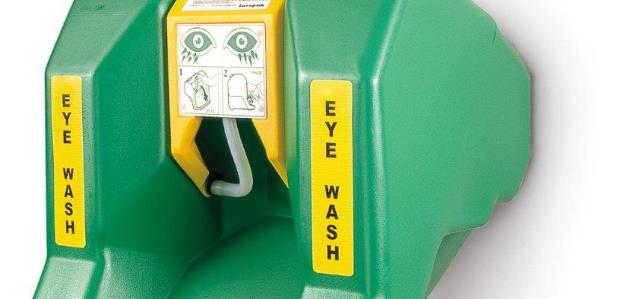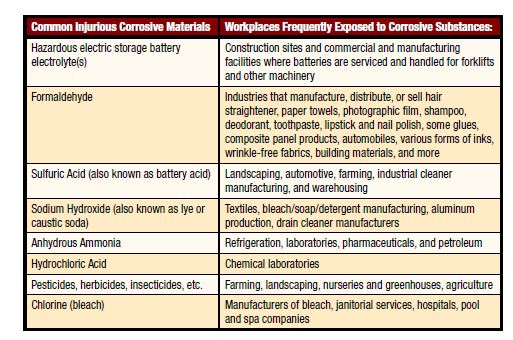
Understanding the ANSI Z358.1-2014 Standard for Plumbed and Portable Eyewash Stations
The ANSI Z358.1-2014 standard serves as a benchmark within the United States and also internationally to help protect workers from eye injuries from caustic and corrosive substances.
- By Mary Padron, Michael Bolden
- Sep 01, 2016
In the Beginning was OSHA
In the beginning was the 1970 Occupational Safety and Health Act (OSHA). To improve worker safety, OSHA adopted several regulations concerning the use of emergency eyewash and shower stations. OSHA's primary regulation concerning eyewash and shower stations can be found in 29 CFR 1910.151. This mandate states:
"Where the eyes or body of any person may be exposed to injurious corrosive materials, suitable facilities for quick drenching or flushing of the eyes and body shall be provided within the work area for immediate emergency use."
What Are Common Injurious Corrosive Materials?
Hazardous substances can be found in many different types of industries.
 OSHA states that a corrosive chemical destroys or irreversibly changes the structure of human tissue at the site of contact after exposure for a specified period of time. In workplaces where corrosive chemicals are handled, OSHA requires that "facilities for drenching or flushing the eyes be provided in the work area for immediate emergency use."
OSHA states that a corrosive chemical destroys or irreversibly changes the structure of human tissue at the site of contact after exposure for a specified period of time. In workplaces where corrosive chemicals are handled, OSHA requires that "facilities for drenching or flushing the eyes be provided in the work area for immediate emergency use."
For a comprehensive list of corrosive and caustic substances, you can refer to Safety Data Sheets (SDS). An SDS is designed to provide workers and emergency personnel with the proper procedures for handling or working with potentially harmful substances. A helpful site on the internet for SDS information is http://www.ilpi.com/msds/.
ANSI Adopts ANSI Z358.1 Eyewash and Shower Equipment Standard in 1981
Because OSHA did not define “suitable facilities” in its primary regulation, this left a big question mark hanging over the heads of employers and safety specialists. Then, in 1981, the American National Standards Institute (ANSI) adopted the ANSI Z358.1 eyewash and shower equipment standard. The standard was revised in 1990, 1998, 2004, and 2009.
Now the ANSI Z358.1-2014 standard serves as a benchmark within the United States and also internationally to help protect workers from eye injuries from caustic and corrosive substances. The standard provides numerous eyewash guidelines, including:
- Proper design of eyewash stations and showers
- Certification and testing procedures
- Performance and usage
- Maintenance of flushing equipment
- Employee training
More About ANSI Z358.1-2014 Requirements
The three primary types of emergency eyewash and shower stations include:
1) Eyewash stations for splashes or spills where only the eyes are likely affected—Require flushing of 0.4 gallons per minute at 30 PSI for 15 minutes.
2) Eye/face wash equipment for splashes or spills where the eyes and face are affected—Require flushing of 3.0 gallons per minute at 30 PSI for 15 minutes.
3) Emergency showers for splashes or spills that affect the larger areas of the body—Require flushing of 20 gallons per minute at 30 PSI for 15 minutes.
Two different types of eyewash stations are acceptable under the ANSI Z 358.1 standard:
- Plumbed permanent eyewash stations
- Self-contained, gravity-fed portable shower and eyewash stations
Plumbed stations are permanently connected to a source of potable water, whereas portable stations are self-contained gravity-fed units with their own flushing fluid that must be replaced after each use.
Portable eyewash stations do not require plumbing and deliver their flushing fluid via potable water (tap water) treated with bacteriostatic solution or via a sealed cartridge with a contaminant-free purified or sterile solution.
Several of the ANSI requirements for plumbed or portable eyewash stations are the same, including:
- Required flushing of 0.4 gallons per minute (GPM) at 30 PSI for a full 15 minutes.
- Hands-free stay-open valve should activate in one second or less.
- The heads of the units (water flow pattern) must be positioned 33" to 53" from the surface on which the user stands and 6" minimum from the wall.
- Eyewash fluid must irrigate and flush both eyes simultaneously.
However, portable eyewash stations have several advantages over plumbed units, including:
- Portability and compact size make them easy to move and place within hazardous areas both in your facility and in the field.
- They offer flexibility to use in remodeled workspaces.
- They can be mounted in tight spaces.
- They require less maintenance than plumbed units.
- They're less expensive than plumbed units, which require the added expense of water lines.
Use of Tepid Water
The standard states that the water temperature for the flushing fluid in an eyewash station must be tepid, which is between 60° and 100° F or 16° and 38° C. Tepid water helps encourage worker compliance to meet the full 15 minutes of flushing which helps prevent further absorption of chemicals and injury to the eyes.
Tepid water can be delivered to eyewash and shower flushing stations by many different means. The most common method is by installing Thermostatic Mixing Valves (TMVs). These valves blend cold and hot water to provide a comfortable flushing fluid within the ANSI temperature range. Enforcement of the tepid water regulation has been on the rise, so make sure your workplace or health care facility (a common target) is in compliance.
Location and the Almighty 10-Second Rule
Eyewash stations should be located on the same level as the hazard in a well-lit area that is properly marked as an emergency eyewash station. It must be positioned within 10 seconds (about 55 feet) of the hazard along a path that is free of obstructions. An obstruction-free path is critical because the vision of injured workers is impaired.
An injured worker naturally wants to close and rub his or her eyes when contact with a harmful substance has been made. If strong caustics or acids are handled, emergency eyewash station should be positioned adjacent to the hazardous area based on advice from an appropriate emergency shower and eyewash professional.
Testing and Maintenance of Plumbed Units vs. Portable Units
ANSI Z358.1 requires that plumbed flushing stations “be activated weekly for a period long enough to verify operation and ensure that flushing fluid is available.” ANSI states that portable equipment “be visually checked to determine if flushing fluid needs to be changed or supplemented.” Whether plumbed or portable, both types also need to be tested annually and maintained according to the manufacturer’s guidelines.
For regular maintenance, portable and plumbed eyewash stations that use tap water (instead of saline solution) as the primary flushing fluid require more attention than portable, saline-solution stations to avoid bacterial growth.
The Importance of Using Saline Solutions for Flushing Fluid Instead of Tap Water
The standard recommends that portable eyewash stations use a preserved, buffered pH-balanced saline solution instead of plain tap water because tap water can cause painful damage even to healthy eyes. Using tap water also requires more maintenance because the unit needs weekly maintenance to remove contaminants, such as mildew and sediment buildup.
According to Dr. Henry Edelhauser, professor of ophthalmology and director of Ophthalmic Research at the Emory University School of Medicine, "Tap water does not have the composition of human tears. Tears are a naturally buffered, salt solution. Tap water is not buffered, nor does it contain any of the necessary salts."
Employee Training
Employees who could be exposed to a hazardous chemical splash or severe dust must be properly trained in the location, use, and operation of an eyewash station. Training needs to occur before an accident happens.
One training role play to employ is to blindfold an employee and have him walk to the eyewash station. This is realistic because injured workers often close their eyes once harmed. Also, instruct your employees to yell for help so another employee can help the injured worker to walk safely and quickly to the eyewash station.
Instruct employees who wear contact lenses to begin flushing over the lens immediately. Flushing may dislodge the contact lens. Of course, employees should seek immediate medical attention.
Make Eye Protection a Workplace Priority
Eyesight is a precious sense that deserves and demands protection. The Centers for Disease Control (CDC) states that each day, about 2,000 U.S. workers have a job-related eye injury that requires medical treatment. According to the volunteer organization Prevent Blindness America, "in 2013, an estimated 94,406 people were treated at U.S. hospital emergency rooms for eye injuries related to workplace or industrial products...."
Although the majority of eye injuries result from small particles or objects striking the eye, chemical burns to eyes from splashes of industrial chemicals or cleaning products, especially bleach, are common. According to the Vision Council and the American Society of Safety Engineers (ASSE), "perhaps most devastating is the fact that while vision loss is among the top 10 disabilities among American adults aged 18 years and older, 90 percent of eye injuries are preventable."
Employers are required to assess eye safety hazards and risks in the workplace and take measures to ensure employee safety through compliance with government regulations for eyewear and emergency eyewash stations. Providing eye protection, including the use of safety glasses, goggles, faceshields, and emergency eyewash stations for first aid, needs to be a priority in every safety program.
If you have questions about the best type of eyewash station or emergency shower for your facility, call a leading manufacturer of PPE. Most industry leaders will have dedicated product specialists or champions who can provide eye protection safety solutions that address your unique workplace hazards and budget considerations.
This article originally appeared in the September 2016 issue of Occupational Health & Safety.